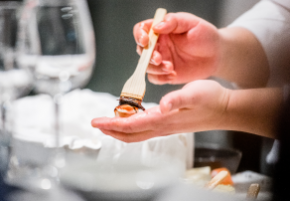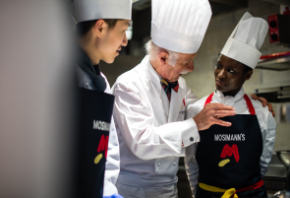- About
- Programs
- Campus Life
- Career Services
- Admissions
- News & Events
- Alumni
International Cuisines: Famous Dishes from Every Region
Explore iconic international cuisines and dishes from around the world. Start your global food journey today!
Key Takeaways
- International cuisines are proof of how connected food is to the human experience.
- Some of the most popular international cuisines include Italian, Japanese, Indian, Chinese, Middle Eastern, Greek, Mexican, French, and Thai.
- Their global popularity has grown through migration, tourism, international trade, and media exposure.
Humans are the only species that cook. In fact, cooking is so central to our lives that it rivals language and art in shaping who we are. What's remarkable is that, across every culture, it has become a powerful way of expressing one's identity and community.
Over time, cooking evolved into distinct systems passed down through generations. These systems, rich in history and technique, have given rise to the diverse international cuisines we recognize today.
What Is International Cuisine?
International cuisine refers to dishes and cooking styles that originate in one country or culture but are known and enjoyed across borders. Unlike local, regional, or even traditional cuisine, which often remain closely tied to specific areas or communities, international cuisines have travelled and taken root in kitchens around the world.
This global spread is often the result of migration, media, trade, tourism, or simply curiosity. You can enjoy sushi in Paris, tacos in Tokyo, or pasta in New York. These are all part of a broader, global culinary exchange, where techniques, ingredients, and philosophies related to cooking are shared and, in some cases, even transformed and adapted.
What makes one cuisine different from another often comes down to a few key factors: the types of basic foods used, the cooking techniques, and the way flavors are balanced.
For example, soy sauce, ginger, and rice wine might signal Chinese cuisine, while olive oil, tomatoes, and oregano might hint at Italian. These ingredient combinations give food a kind of accent—instantly recognizable and deeply tied to place and tradition.
Popular International Cuisines Around the World
You can simply be strolling through a local neighborhood and are likely to stumble upon a cozy ramen shop, a taco stand, or a bakery offering flaky croissants. They have become part of world cuisines, and many of their dishes have made their way into mainstream menus.
Some of the most popular and widely loved cuisine options include the following:
Italian cuisine
Pasta and pizza are arguably the two most beloved dishes in Italian cuisine and worldwide. This cuisine uses simple ingredients—wheat-based products like pasta and bread, olive oil, tomatoes, garlic, fresh herbs, and a variety of vegetables such as eggplant, zucchini, and leafy greens.
Italian cooking often features meats like beef, veal, and pork, as well as seafood in coastal regions. Olive oil is central to many recipes, sometimes combined with anchovies, garlic, or fresh herbs to create rich flavor bases. Wine and cheese—from Parmigiano-Reggiano to mozzarella— are also often used in sauces.
A few classic dishes from this cuisine include:
- Pasta
- Lasagna
- Pizza
- Risotto alla Milanese
- Osso buco
- Tiramisu
- Cannoli
Japanese cuisine
Instead of relying heavily on spices or fats, Japanese cooking builds flavor through subtle layering and a combination of many different ingredients. Many dishes use soy sauce, rice wine (sake), and sugar or mirin, a sweet rice wine used in cooking. These ingredients help create a gentle, umami-rich profile that complements dishes like teriyaki or yakitori.
This cuisine favors cooking techniques like broiling, poaching, and steaming over frying, thus resulting in lighter meals. That said, even when deep frying is used, as in the case of tempura, it's done with a light hand to preserve the ingredient's natural texture and taste.
This cuisine is best known for dishes like:
- Sushi
- Ramen
- Tempura
- Gyoza
- Udon
- Sashimi
- Miso soup
Indian cuisine
Indian cuisine is one of the most diverse due to thousands of years of cultural exchange, religious influence, and regional adaptation. With a foundation built on grains like rice and wheat, legumes, vegetables, and an extraordinary range of spices, Indian food reflects both necessity and creativity, especially in a country where vegetarianism is widely practiced and meat is often limited by religious or environmental factors.
Spices are central to Indian cooking. However, what many know simply as "curry" abroad is actually a vast category of saucy dishes, each with its unique seasoning blend. In India, there's no single "curry powder"—spices like cumin, turmeric, coriander, cardamom, cloves, and mustard seed are ground and combined in specific proportions for each dish, region, and family tradition.
Signature meals from this cuisine include:
- Butter chicken
- Biryani
- Palak paneer
- Samosa
- Dal Tadka
- Naan
- Gulab jamun
Chinese cuisine
Rice is the staple food throughout much of China, especially in the south, while the north leans more on wheat-based items like noodles and dumplings. Chinese noodles come in countless forms, made from rice flour, wheat, or even mung bean starch.
Alongside grains, the cuisine features a wide range of proteins, including chicken, duck, pork, and seafood, as well as an impressive variety of fresh vegetables, often grown locally, even in small home gardens.
One of the most iconic cooking techniques in China is stir-frying—quick, high-heat cooking in a wok that locks in flavor and preserves the natural textures of the ingredients. Techniques like steaming, braising, and deep-frying are also common and used to bring out the best qualities of each ingredient.
Popular dishes from this cuisine include:
- Peking duck
- Kung pao chicken
- Dim sum
- Mapo tofu
- Chow mein
- Sweet and sour pork
- Spring rolls
Thai cuisine
Thai cuisine is known for its bold flavors and aromatic ingredients. Influenced by neighboring countries like China, Vietnam, Laos, and Cambodia, it shares staples such as rice, noodles, fresh herbs, and a wide variety of meats, fish, and vegetables—but its flavor profile is distinctly its own.
A core component of Thai flavor is nam pla, or fish sauce, which gives the dishes their signature umami depth. Thai food also makes generous use of garlic and bird's eye chili, as well as fresh coriander—both the leaves and roots—especially in marinades and curry pastes.
Commonly served dishes from this cuisine are:
- Pad thai
- Tom yum goong
- Green curry
- Som tum
- Pad see ew
- Khao pad (Thai fried rice)
- Mango sticky rice
Mexican cuisine
When Spanish conquistadores arrived in Mexico, they encountered a rich culinary tradition centered on corn, beans, squash, and chile-based sauces—ingredients that still define Mexican meals today.
The Spanish introduced wheat, rice, beef, pork, citrus fruits, and new cooking methods such as frying in fat. While these additions were embraced, they merged with indigenous practices rather than replacing them. The result is a cuisine that feels both ancient and evolving.
Chilies, tomatoes, lime juice, garlic, onions, and spices like cumin and cinnamon build the flavor foundations of many Mexican dishes.
Two different seasoning combinations—tomato with chile and lime with chile—are common in sauces, salsas, and marinades. Fresh coriander (cilantro) is a common finishing touch.
Some well-known and loved examples of this cuisine are:
- Tacos
- Chiles en nogada
- Tamales
- Pozole
- Enchiladas
- Guacamole
- Tres leches cake
Middle Eastern cuisine
Situated at the intersection of Europe, Asia, and Africa, the Middle East has historically acted as a crossroads, enabling its culinary traditions to embrace various influences while maintaining a distinct and unique identity.
The region's staples, like wheat, barley, chickpeas, fava beans, and lamb, reflect its ancient agricultural heritage.
Cooking techniques encompass oven-baking, slow simmering in liquid, and utilizing yogurt as both an ingredient and a sauce base. Spit-roasting continues to be popular for meats like lamb and chicken, delivering flavor-packed dishes such as shawarma.
Cinnamon is used generously—not only in sweets but also in savory stews and sauces. Fresh herbs like parsley, mint, and dill are also essential, while lemon juice brings brightness and acidity, much like vinegar does in other parts of the world.
Two major flavor combinations stand out in particular: the pairing of tomato and cinnamon, often elevated with lemon or dill, and the refreshing blend of lemon and parsley, sometimes combined with garlic and mint.
Some staple dishes of this cuisine are:
- Hummus
- Falafel
- Shawarma
- Kebabs
- Baba ghanoush
- Kunafa
- Baklava
French cuisine
French cuisine is known around the world for being elegant and flavorful. It has a global reputation for its refinement and luxurious ingredients like truffle and caviar.
Another reason French cuisine stands out is its amazing dairy products. French butter, cream, and cheese—like Camembert—are considered some of the best. These ingredients, along with fresh herbs and vinegar, are used instead of heavy spices to bring flavor to dishes.
Famous dishes and pastries from this cuisine are:
- Coq au vin
- Boeuf bourguignon
- Quiche
- Croissant
- Soufflé
- Macarons
- Crème brûlée
Greek cuisine
Greek cuisine beautifully bridges the flavors of the Mediterranean with those of the Middle East, reflecting its unique geographic and cultural crossroads. Unlike many European regions that rely heavily on leavened white bread, Greece retains older traditions like baking pita—a flat, round bread—and using yogurt and spit-roasted meats, both culinary practices with roots in Central Asia.
A distinctive Greek flavor pairing is tomato with cinnamon—a nod to Middle Eastern influence. But perhaps the most defining taste of Greek cuisine comes from the hillsides themselves: wild oregano (or wild thyme), which grows naturally and has flavored local dishes for centuries. Blended with olive oil and lemon juice, it creates the unmistakable bright and herbal character found in everything from grilled meats to salads.
You can find the following dishes in this cuisine:
- Moussaka
- Souvlaki
- Spanakopita
- Dolmades
- Greek Salad (Horiatiki)
- Loukoumades
- Tzatziki
Factors Affecting the Popularity of International Cuisines
One of the key factors why international cuisines are popular and spread across the world is people moving and bringing their food traditions with them. In certain cases, their home recipes turn into local restaurants, food trucks, or bakeries that are embraced by locals, too. Over time, these foods and cuisines become part of the new community’s dining options.
Global trade also helps make it easier to find ingredients from almost anywhere—avocados from Mexico, spices from India, noodles from Japan, or sauces from Italy. At the same time, international tourism exposes travelers to new flavors and dining experiences, which they may crave once they return home. This demand pushes restaurants, grocery stores, and even frozen food brands to offer more global options.
There are also many cases when TV shows, documentaries, cooking competitions, and social media have made food from different cuisines popular, especially online. A celebrity chef featuring a lesser-known cuisine or a food trend going viral—like Korean corn dogs on TikTok or bao buns on Instagram—naturally sparks curiosity. People want to try it for themselves, and that drives interest in the culture behind the dish, too.
In recent years, health and lifestyle choices have added another layer to this global food movement. As more people prioritize diets that are plant-based, gluten-free, organic, or low in sugar or carbs, they tend to turn to international cuisines that naturally meet those needs. For example, the Mediterranean diet is praised for its heart-healthy ingredients, while Indian and Middle Eastern cuisines offer a range of flavorful vegetarian dishes.
Bring the World to Your Plate
Like so many culinary terms—whether it be the French "mise en place" or the Italian "al dente"—the flavors and dishes of different cuisines cross borders, too. What truly matters for a chef is knowing how to balance those flavors and make the most of the ingredients in front of them. That might sound overwhelming at first, but for someone with proper training—someone with a culinary degree—it becomes second nature and even something to look forward to.
At Culinary Arts Academy Switzerland (CAAS), our kitchens are a global meeting point where students from around the world come together to learn, create, and share. You’ll be guided by award-winning chefs and inspired by classmates who bring their own culinary heritage to every dish.
If you're ready to turn your passion for international cuisine into a professional skillset, explore our Culinary Arts Bachelor's program and start building a career that’s as diverse as your palate.
Frequently Asked Questions
What are some underrated international cuisines to try?
Some cuisines that often fly under the radar but are well worth exploring include Filipino, Peruvian, Georgian, and Turkish.
How to experience new international cuisines?
You could try visiting authentic local restaurants, joining food tours, following global chefs online, or even taking a cooking class and preparing the dishes yourself.
Interested in studying at CAAS? Download our brochure to learn about our programs!






























